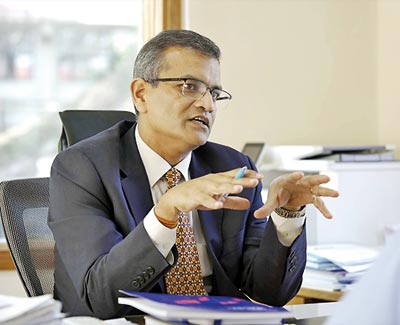Sri Lanka’s agriculture sector needs modernisation
While the agriculture sector in Sri Lanka is becoming more and more archaic with every passing year, artificial intelligence enabled technologies, sophisticated computerised methods and drone technology are the future of the sector. The time is right for modernising Sri Lanka’s agriculture sector, says Mr. Vimlendra Sharan, UN Food and Agriculture Organisation (FAO), Representative to Sri Lanka and the Maldives.

Mr. Vimlendra Sharan
During an interview with the Business Times, Mr. Sharan stressed that the time is right for modernising Sri Lanka’s agriculture sector.
Highlighting how the industry was doing well in the past, Mr. Sharan stated, “Sri Lanka’s agriculture sector is vibrant and has done well in the past. It has grown quite exponentially in terms of production over the last couple of decades. There has been a drop in the production following the COVID pandemic and economic crisis, but fortunately adequate help came from bilateral and multilateral partners including the UN agencies to help bring the sector back on track to the smallholder farmers.”
“Through the FAO we were able to provide Triple Superphosphate (TSP) fertiliser to all the paddy farmers in the country. This was facilitated with the funds received from the USAID (US$46 million). In addition, funds also came from Japan and the EU which has gone in to provide other fertiliser imports such as urea. USAID fund was threefold, for urea, TSP and cash grants. EU funding was for urea and capacity building. Japan funding was for urea. UK and Sweden funding were for cash transfers.”
He mentioned that during the emergency phase, FAO worked with the farmers on issues around fertiliser utilisation and how to reduce the import of resources without compromising on production. Through the programmes with the farmers in multiple districts, production levels picked up while application of fertiliser, chemical, and pesticides reduced. FAO also looked at better agronomic practices, better technologies and capacity building.
Paddy production has nearly come back to its pre-crisis levels. On average Sri Lanka produces about two million metric tonnes (MT) of paddy during the ‘Yala’ season. During the 2023‘Yala’ season Sri Lanka produced 1.9 million MT of paddy, Mr. Sharan noted.
He also stated that for the first time in Sri Lanka drones are used to do the seeding. “The advantage of drone seeding is that unlike other machines a drone is size neutral. So it can be even used on small plots of land for seeding of paddy.” FAO is also working with agencies on the integrated plant nutrient management strategy. About 6000 farmers are now trained at 300 farmer field schools in the country. The training is on integrated plant nutrient management strategy, a combination of providing nutrient to the plant, bringing a mix of bio fertilisers, chemical fertilisers, precision irrigation techniques which effectively will make agriculture sustainable, lower the carbon footprint the agriculture sector has on climate.”
He also highlighted that the Sri Lankan Government has agreed to host the 37th session of the Asia Pacific Regional Conference scheduled for next month.
Hitad.lk has you covered with quality used or brand new cars for sale that are budget friendly yet reliable! Now is the time to sell your old ride for something more attractive to today's modern automotive market demands. Browse through our selection of affordable options now on Hitad.lk before deciding on what will work best for you!


